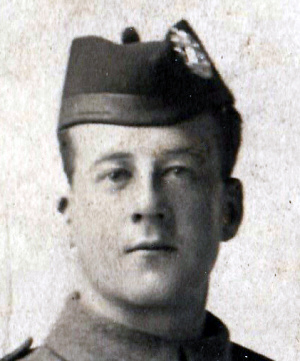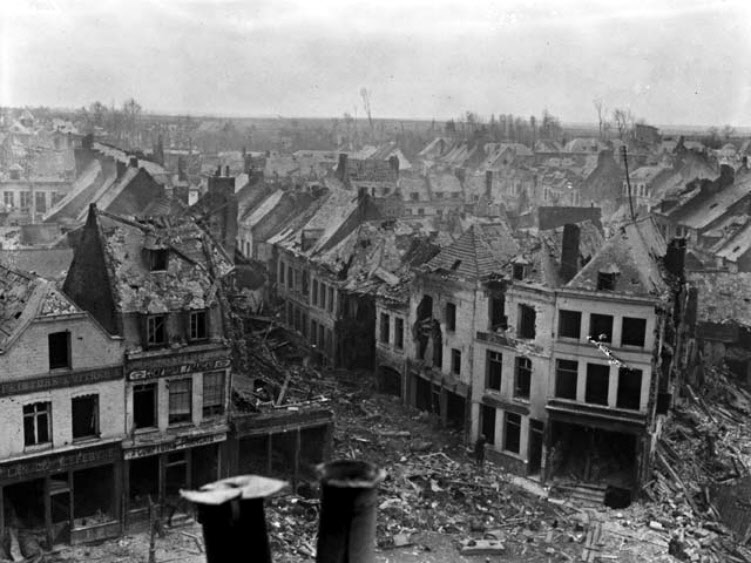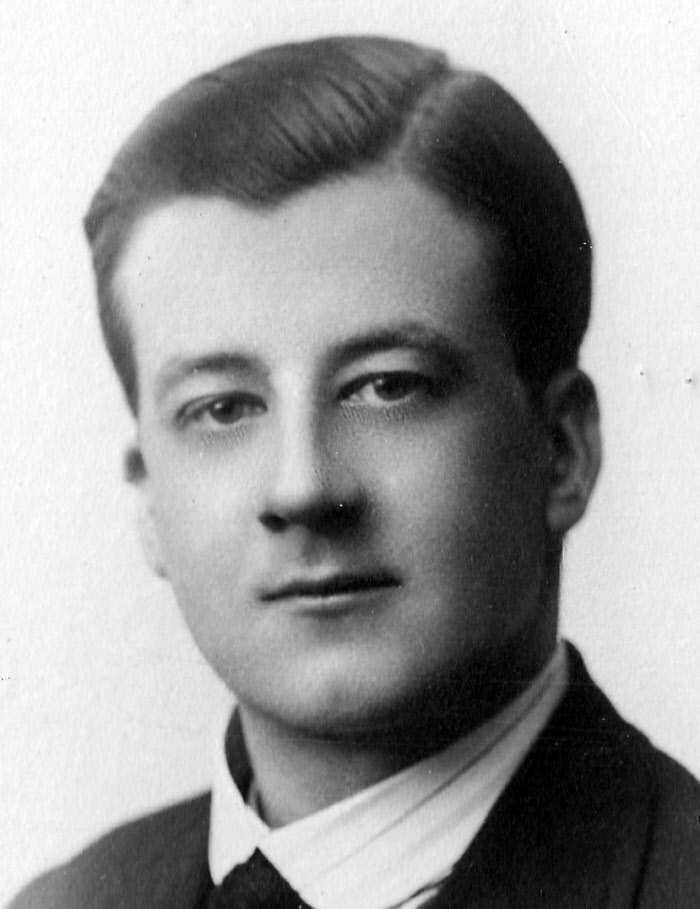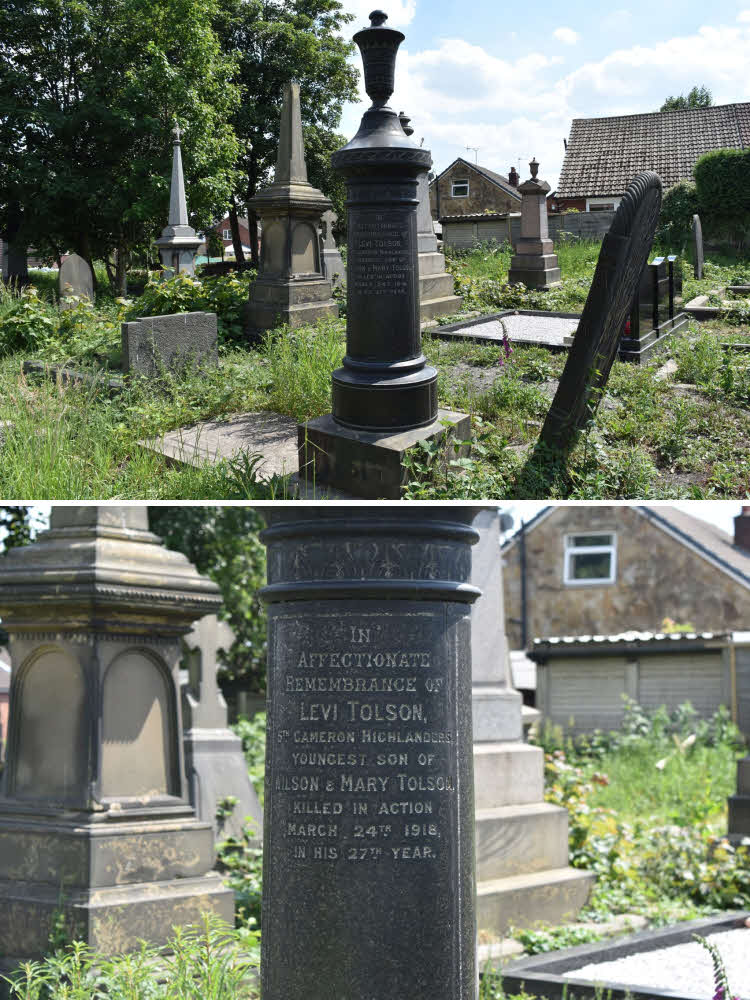
Levi Tolson was born in Ossett in 1891, the sixth son of Ossett mason contractor Wilson Tolson and his wife Mary (nee Horton) who had married in 1878. In 1891, the Tolson family were living in Headlands, Ossett and there were seven children of which six were boys. By 1911, Wilson Tolson was a widower, having lost his wife Mary in 1906, and the family were living then at Runtlings House, Ossett.
During WW1, Levi Tolson became a fireman, and after the Zeppelin raids on London in 1915 and 1916, he went to the capital to help with the extensive fire damage. On his return to Ossett, he was apprehended by some local people who gave him several white feathers – the symbol of cowardice, which greatly upset him. It was this which caused him to join up, even though his job as a fireman, a reserved occupation, probably meant he didn’t need to do so. As a result Tolson joined the 5th Battalion of the Cameron Highlanders and was to lose his life in the German Spring Offensive of 1918.1
The 5th (Service) Battalion of the Queen’s Own Cameron Highlanders was formed at Inverness in August 1914 as part of K1 and came under orders of 26th Brigade in the 9th (Scottish) Division. They moved to Aldershot and in February 1915 went to Bordon. They landed at Boulogne on the 10th of May 1915.
In early April 1918, the “Ossett Observer” had a report that Levi Tolson was missing:
“Private Levi Tolson of the Cameron Highlanders, a well-known Ossett young man, the sixth son of Mr. Wilson Tolson of Runtlings House, Ossett, is reported missing, and believed to be a prisoner in enemy hands. In a letter his company officer expresses regret at losing him ‘as he was a good fellow, in fact, a real Cameron – and the Camerons fight like tigers.’ Private Tolson worked fro his father as a mason before enlistment.”
Levi Tolson died on the 24th March 1918 at the The First Battle of Bapaume as part of the 9th (Scottish) Division, which the 5th Cameron Highlanders were attached:
“March 1918 saw the 9th (Scottish) Division in the line before Gouzeaucourt, east of Bapaume, where the German offensive, launched on the 21st March, forced the 9th into a fighting withdrawal, in which a large part of the South African Brigade was cut off and wiped out, fighting to the last. By the 26th March, the strength of the Division had been reduced to 1,340 men and two days later they were withdrawn from the line. The 9th (Scottish) Division had gone down fighting, and had earned the admiration of friend and foe alike. By their dogged resistance, the men of the division had bought the time needed to stem the German advance, whilst extracting a heavy toll of the enemy. They had significantly helped to save the British Army from a disaster, earning the praise of Sir Douglas Haigh: “Great gallantry has been shown by the troops engaged in the fighting – the 19th and 9th Divisions have distinguished themselves by the valour of their defence.” 2
Levi Tolson’s army service record has not survived but it is known that he enlisted in Ossett and was posthumously awarded the British and Victory campaign medals. He was not awarded the 1914/15 Star indicating that he did not serve overseas on or before 31st December 1915.

Above: Bapaume in ruins during WW1.
Private Levi Tolson is remembered on Panel 74 at the Pozieres Memorial 3, Somme, France. Pozieres is a village 6 kilometres north-east of the town of Albert. The Memorial encloses Pozieres British Cemetery which is a little south-west of the village on the north side of the main road, D929, from Albert to Pozieres.
The Pozieres Memorial relates to the period of crisis in March and April 1918 when the Allied Fifth Army was driven back by overwhelming numbers across the former Somme battlefields, and the months that followed before the Advance to Victory, which began on 8 August 1918. The Memorial commemorates over 14,000 casualties of the United Kingdom and 300 of the South African Forces who have no known grave and who died on the Somme from 21 March to 7 August 1918.
The Corps and Regiments most largely represented are The Rifle Brigade with over 600 names, The Durham Light Infantry with approximately 600 names, the Machine Gun Corps with over 500, The Manchester Regiment with approximately 500 and The Royal Horse and Royal Field Artillery with over 400 names.

Above: Levi Tolson, photograph courtesy of lhe late Mrs Madge Latimer (née Tolson) – Levi Tolson’s niece.
Levi Tolson’s older brother Fred Horton Tolson (born 1887) was wounded in action in 1918 during WW1 and the “Ossett Observer” had some details:
“Private Fred H. Tolson, the fourth son of Mr. Wilson Tolson of Ossett has been wounded in France. Describing in a letter to his wife, who lives in Industrial-street, Horbury, how he received his injuries, Private Tolson says that he was engaged in an attack on a German reserve trench, when a shell burst near him, and he received a bullet through the right leg. ‘I lay where I was until I came round and found my leg had been hit. Three Germans then came out of a trench and gave themselves up to me. I motioned for them to come on, and they picked me up and carried me to our nearest stretcher bearers. I had my leg dressed and was then left in a shell-hole. The enemy then started sending heavy shells over, and I thought it wisest to try and crawl out of danger.’ With the aid of two sticks he had picked up, he managed to hobble for three hours and a half, when he reached a dug-out, where several other wounded men were resting. ‘We had been there about a quarter of an hour’ he continues ‘when two shells dropped on top and knocked it in, but I was lucky in not getting a scratch. I scrambled out, and carried on, plastered from head to foot, until I reached our trenches.’ He added that he was mending nicely and expected to be sent to ‘Blighty’ in a few days.”

Above: The Tolson grave at St. John’s Methodist Chapel showing the memorial to Levi Tolson, the son of Wilson Tolson. Picture courtesy of Lisa Jennings.
References:
1. Personal recollection of Levi Tolson’s grand-niece, Nancy Dransfield as related to Alan Howe in August 2014.
1. “Scottish Divisions in the World Wars”, by Mike Chappell, Osprey Publishing 1994, ISBN 1-85532-469-5